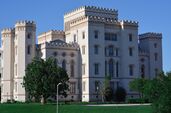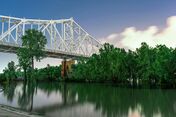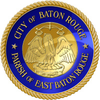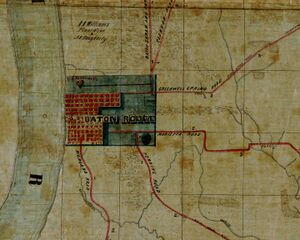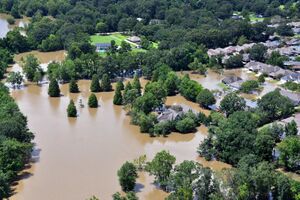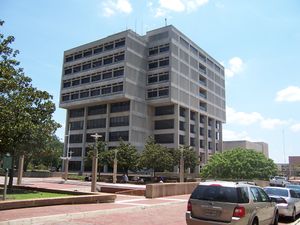باتون روج، لويزيانا
Baton Rouge | |
|---|---|
| City of Baton Rouge | |
| أصل الاسم: من بالفرنسية Bâton-Rouge، وتعني "red stick" | |
| الكنية: Red Stick, The Capital City, B.R. | |
 Interactive map of Baton Rouge | |
| الإحداثيات: 30°26′51″N 91°10′43″W / 30.44750°N 91.17861°WCoordinates: 30°26′51″N 91°10′43″W / 30.44750°N 91.17861°W | |
| Country | United States |
| State | Louisiana |
| Parish | East Baton Rouge |
| Founded | 1699 |
| Settled | 1721 |
| Incorporated | January 16, 1817 |
| الحكومة | |
| • Mayor-President | Sharon Weston Broome[1] (D) |
| المساحة | |
| • State capital city and consolidated city-parish | 88٫52 ميل² (229٫27 كم²) |
| • البر | 86٫32 ميل² (223٫56 كم²) |
| • الماء | 2٫20 ميل² (5٫71 كم²) |
| • Total[note 1] | 79٫11 ميل² (204٫89 كم²) |
| المنسوب | 46 ft (14 m) |
| التعداد (2020) | |
| • State capital city and consolidated city-parish | 227٬470 |
| • الترتيب | US: 99th |
| • الكثافة | 2٬635٫32/sq mi (1٬017٫50/km2) |
| • Urban | 631٬326 (US: 67th) |
| • الكثافة الحضرية | 1٬592٫9/sq mi (615٫0/km2) |
| • العمرانية | 870٬569 (US: 66th) |
| صفة المواطن | Baton Rougean |
| منطقة التوقيت | UTC−6 (CST) |
| • الصيف (التوقيت الصيفي) | UTC−5 (CDT) |
| ZIP Codes | 70801–70817, 70819–70823, 70825–70827, 70831, 70833, 70835–70837, 70874, 70879, 70883, 70884, 70892–70896, 70898 |
| مفتاح الهاتف | 225 |
| FIPS code | 22-05000 |
| GNIS feature ID | 1629914 |
| الموقع الإلكتروني | www |
باتون روج ( Baton Rouge ؛ /ˌbætən ˈruːʒ/ BAT-ən ROOZH; من بالفرنسية Bâton-Rouge، وتعني "red stick") عاصمة ولاية لويزيانا وثاني أكبر مدنها. Located on the eastern bank of the Mississippi River, it is the parish seat of East Baton Rouge Parish,[4] Louisiana's most populous parish (the equivalent of counties in other states).[5] Since 2020, it has been the second-largest city in Louisiana after New Orleans; Baton Rouge is the 18th-most-populous state capital. According to the 2020 United States census,[6] the city-proper had a population of 227,470; its consolidated population was 456,781 in 2020.[7] The city is the center of the Greater Baton Rouge area—Louisiana's second-largest metropolitan area—with a population of 870,569 as of 2020,[8] up from 802,484 in 2010.[9] Baton Rouge is the fourth most populous city proper in the Deep South region of the southeastern United States.
The Baton Rouge area owes its historical importance to its strategic site upon the Istrouma Bluff, the first natural bluff upriver from the Mississippi River Delta at the Gulf of Mexico. This allowed development of a business quarter safe from seasonal flooding. In addition, it built a levee system stretching from the bluff southward to protect the riverfront and low-lying agricultural areas.[10]
It has developed as a culturally rich center, with settlement by immigrants from numerous European nations and African peoples brought to North America as slaves or indentured servants. It was ruled by seven different governments: French, British, and Spanish in the colonial era; the Republic of West Florida; as a United States territory and state; Confederate, and United States again since the end of the American Civil War. Through the various occupying national governments of Baton Rouge, the city and its metropolitan area have developed as a multicultural region practicing many religious traditions from Catholicism to Protestantism, and Louisiana Hoodoo the area has also become home to a sizeable lesbian, gay, bisexual and transgender community,[11] and elected the first open LGBT politician for the Louisiana Public Service Commission.[12]
Baton Rouge is a major industrial, petrochemical, medical, research, motion picture,[13] and growing technology center of the American South.[14] It is the location of Louisiana State University—the LSU system's flagship university and the state's largest institution of higher education.[15] It is also the location of Southern University, the flagship institution of the Southern University System—the nation's only historically black college system.[16] The Port of Greater Baton Rouge is the tenth-largest in the U.S. by tonnage shipped, and is the farthest upstream Mississippi River port capable of handling Panamax ships.[17][18] Major corporations participating in the Baton Rouge metropolitan statistical area's economy include Amazon, Lamar Advertising Company, BBQGuys, Marucci Sports, Piccadilly Restaurants, Raising Cane's Chicken Fingers, ExxonMobil, Brown & Root, Shell, and Dow Chemical Company.
تأسست عام 1712 كانت مشهورة بكثرة رعاة البقر وقد كانت شهيرة جدا وقد كانت تحت حكم فرنسا إلى أن اشترتها الولايات المتحدة بسعر زهيد فيما سمي شراء لويزيانا. ويعرفها الكثير من الناس من بطلها الشعبي هيفي كروكت يبلغ عدد سكانها 222.064 نسمة هي أهم مدن الولاية وذلك لأنها بعيدة عن الأعاصير التي تصيب ولاية لويزيانا.
. . . . . . . . . . . . . . . . . . . . . . . . . . . . . . . . . . . . . . . . . . . . . . . . . . . . . . . . . . . . . . . . . . . . . . . . . . . . . . . . . . . . . . . . . . . . . . . . . . . . . . . . . . . . . . . . . . . . . . . . . . . . . . . . . . . . . . . . . . . . . . . . . . . . . . . . . . . . . . . . . . . . . . . .
التاريخ
Pre-history
Human habitation in the Baton Rouge area has been dated to 12000–6500 BC, based on evidence found along the Mississippi, Comite, and Amite rivers.[19][20] Earthwork mounds were built by hunter-gatherer societies in the Middle Archaic period, from roughly the fourth millennium BC.[21] The speakers of the Proto-Muskogean language divided into its descendant languages by about 1000 BC; and a cultural boundary between either side of Mobile Bay and the Black Warrior River began to appear between about 1200 BC and 500 BC—a period called the Middle "Gulf Formational Stage". The Eastern Muskogean language began to diversify internally in the first half of the first millennium AD.[22]
The early Muskogean societies were the bearers of the Mississippian culture, which formed around 800 AD and extended in a vast network across the Mississippi and Ohio valleys, with numerous chiefdoms in the Southeast, as well. By the time the Spanish made their first forays inland from the shores of the Gulf of Mexico in the early 16th century, by some evidence many political centers of the Mississippians were already in decline, or abandoned. At the time, this region appeared to have been occupied by a collection of moderately sized native chiefdoms, interspersed with autonomous villages and tribal groups.[23] Other evidence indicates these Mississippian settlements were thriving at the time of the first Spanish contact. Later Spanish expeditions encountered the remains of groups who had lost many people and been disrupted in the aftermath of infectious diseases, chronic among Europeans, unknowingly introduced by the first expedition.
Colonial period

French explorer Pierre Le Moyne d'Iberville led an exploration party up the Mississippi River in 1698. The explorers saw a red pole marking the boundary between the Houma and Bayagoula tribal hunting grounds. The French name le bâton rouge ("the red stick") is the translation of a native term rendered as Istrouma, possibly a corruption of the Choctaw iti humma ("red pole");[24] André-Joseph Pénicaut—a carpenter traveling with d'Iberville—published the first full-length account of the expedition in 1723. According to Pénicaut:
From there [Manchacq] we went five leagues higher and found very high banks called écorts in that region, and in savage called Istrouma which means red stick [bâton rouge], as at this place there is a post painted red that the savages have sunk there to mark the land line between the two nations, namely: the land of the Bayagoulas which they were leaving and the land of another nation—thirty leagues upstream from the baton rouge—named the Oumas.
The red pole was presumably at Scott's Bluff, on what is now the campus of Southern University.[25] It was reportedly a 30-foot-high (9.1 m) painted pole adorned with fish bones.[26]
European settlement of Baton Rouge began in 1721 when French colonists established a military and trading post. Since then, Baton Rouge has been governed by France, Britain, Spain, Louisiana, the Republic of West Florida, the United States, the Confederate States, and the United States again. In 1755, when French-speaking settlers of Acadia in Canada's Maritime provinces were expelled by British forces, many took up residence in rural Louisiana. Popularly known as Cajuns, the descendants of the Acadians maintained a separate culture. During the first half of the 19th century, Baton Rouge grew steadily as the result of steamboat trade and transportation.
Incorporation and growth
Baton Rouge was incorporated in 1817. In 1822, the Pentagon Barracks complex of buildings was completed. The site has been used by the Spanish, French, British, Confederate States Army, and United States Army and was part of the short-lived Republic of West Florida.[27] In 1951, ownership of the barracks was transferred to the state of Louisiana. In 1976, the complex was listed on the National Register of Historic Places.[28]
Acquisition of Louisiana by the United States in 1803 was a catalyst for increased Anglo-American settlement, especially in the northern part of the state. In 1846, the state legislature designated Baton Rouge as Louisiana's new capital to replace "sinful" New Orleans. The architect James Dakin was hired to design the old Louisiana State Capitol, with construction beginning in late 1847.[25]
Rather than mimic the United States Capitol, as many other states had done, he designed a capitol in Neo-Gothic style, complete with turrets and crenellations, and stained glass; it overlooks the Mississippi. It has been described as the "most distinguished example of Gothic Revival" architecture in the state and has been designated as a National Historic Landmark.[29]
By the outbreak of the American Civil War, the population of Baton Rouge was nearly 5,500. The war nearly halted economic progress, except for businesses associated with supplying the Union Army occupation of the city, which began in the spring of 1862 and lasted for the duration of the war. The Confederates at first consolidated their forces elsewhere, during which time the state government moved to Opelousas and later Shreveport.[25] In the summer of 1862, about 2,600 Confederate troops under generals John C. Breckinridge (the former Vice President of the United States) and Daniel Ruggles attempted to recapture Baton Rouge.
After the war, New Orleans temporarily served as the seat of the Reconstruction era state government. When the Bourbon Democrats regained power in 1882, after considerable intimidation and voter suppression of black Republicans, they returned the state government to Baton Rouge, where it has since remained. In his 1893 guidebook, Karl Baedeker described Baton Rouge as "the Capital of Louisiana, a quaint old place with 10,378 inhabitants, on a bluff above the Mississippi".[30]
In the 1950s and 1960s, the petrochemical industry boomed in Baton Rouge, stimulating the city's expansion beyond its original center. The changing market in the oil business has produced fluctuations in the industry, affecting employment in the city and area.
A building boom began in the city in the 1990s and continued into the 2000s, during which Baton Rouge was one of the fastest-growing cities in the Southern United States in terms of technology.[31] Metropolitan Baton Rouge was ranked as one of the fastest-growing metropolitan areas in the U.S. (with a population under 1 million), with 602,894 in 2000 and 802,484 people as of the 2010 U.S. census.[32] After the extensive damage in New Orleans and along the coast from Hurricane Katrina on August 29, 2005, the city took in as many as 200,000 displaced residents.
In 2010, Baton Rouge started a market push to become a test city for Google's new super high speed fiber optic line known as GeauxFiBR.[33]
In July 2016, the Greater Baton Rouge metropolitan area was heavily affected by the shooting of Alton Sterling;[34] their death led to multiple protests and the shooting of police officers.[35][36][37][38] President Barack Obama also made remarks on the shooting of Alton Sterling.[39] By February 2021, Sterling's family was given a $4.5 million settlement to settle a wrongful death lawsuit.[40][41] In August 2016, the city and metropolitan area were severely flooded.[42][43]
During the runoff for District 3 of the Louisiana Public Service Commission in December 2022, many Baton Rougeans helped elect Davante Lewis—the first openly LGBT politician to the state government.[44][12]
Geography
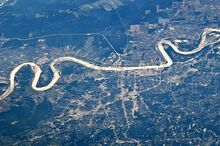
The city of Baton Rouge lies on the banks of the Mississippi River in southeastern Louisiana's Florida Parishes region.[45] The city is about 79 miles (127 km) from New Orleans,[46] 126 miles (203 km) from Alexandria,[47] 56 miles (90 km) from Lafayette and 250 miles (400 km) from Shreveport.[48] It is also 173 miles (278 km) from Jackson, Mississippi and 272 miles (438 km) from Houston, Texas.[49][50] Baton Rouge lies on a low elevation of 56 to a little over 62 feet above sea level.[51]
Baton Rouge is the capital of Louisiana and the parish seat of East Baton Rouge Parish. According to the United States Census Bureau, the city has an area of 79.15 square miles (205.0 km2), of which 76.95 square miles (199.3 km2) are land and 2.2 square miles (5.7 km2) (2.81%) are covered by water.[52] The city is on the first set of bluffs north of the Mississippi River Delta's coastal plains. Because of its prominent location along the river and on the bluffs, which prevents flooding, the French built a fort in the city in 1719.[53] Baton Rouge is the third-southernmost capital city in the continental United States, after Austin, Texas, and Tallahassee, Florida. It is the cultural and economic center of the Greater Baton Rouge metropolitan area.
Climate
| بيانات مناخ Baton Rouge, Louisiana (Metropolitan Airport), 1991–2020 normals,[note 2] extremes 1892–present | |||||||||||||
|---|---|---|---|---|---|---|---|---|---|---|---|---|---|
| الشهر | يناير | فبراير | مارس | أبريل | مايو | يونيو | يوليو | أغسطس | سبتمبر | اكتوبر | نوفمبر | ديسمبر | العام |
| العظمى القياسية °ف (°س) | 85 (29.4) |
88 (31.1) |
93 (33.9) |
96 (35.6) |
101 (38.3) |
103 (39.4) |
103 (39.4) |
110 (43.3) |
104 (40) |
98 (36.7) |
89 (31.7) |
88 (31.1) |
110 (43٫3) |
| العظمى المتوسطة °ف (°س) | 62.3 (16.83) |
66.6 (19.22) |
73.0 (22.78) |
79.1 (26.17) |
85.8 (29.89) |
90.5 (32.5) |
91.9 (33.28) |
92.2 (33.44) |
88.7 (31.5) |
80.9 (27.17) |
71.0 (21.67) |
64.3 (17.94) |
78٫9 (26٫06) |
| المتوسط اليومي °ف (°س) | 52.0 (11.11) |
55.9 (13.28) |
62.0 (16.67) |
68.0 (20) |
75.5 (24.17) |
81.0 (27.22) |
82.9 (28.28) |
82.8 (28.22) |
78.8 (26) |
69.5 (20.83) |
59.4 (15.22) |
53.8 (12.11) |
68٫5 (20٫28) |
| الصغرى المتوسطة °ف (°س) | 41.6 (5.33) |
45.3 (7.39) |
51.0 (10.56) |
56.9 (13.83) |
65.1 (18.39) |
71.5 (21.94) |
73.8 (23.22) |
73.3 (22.94) |
68.9 (20.5) |
58.1 (14.5) |
47.8 (8.78) |
43.3 (6.28) |
58٫0 (14٫44) |
| الصغرى القياسية °ف (°س) | 9 (-12.8) |
2 (-16.7) |
20 (-6.7) |
31 (-0.6) |
40 (4.4) |
53 (11.7) |
58 (14.4) |
58 (14.4) |
43 (6.1) |
30 (-1.1) |
21 (-6.1) |
8 (-13.3) |
2 (−16٫7) |
| هطول inches (mm) | 6.36 (161.5) |
4.42 (112.3) |
4.46 (113.3) |
5.08 (129) |
5.23 (132.8) |
6.45 (163.8) |
5.09 (129.3) |
6.37 (161.8) |
4.42 (112.3) |
4.84 (122.9) |
3.90 (99.1) |
5.32 (135.1) |
61٫94 (1٬573٫3) |
| سقوط الثلج inches (cm) | 0.0 (0) |
0.0 (0) |
0.0 (0) |
0.0 (0) |
0.0 (0) |
0.0 (0) |
0.0 (0) |
0.0 (0) |
0.0 (0) |
0.0 (0) |
0.0 (0) |
0.2 (0.5) |
0٫2 (0٫5) |
| % Humidity | 74.1 | 70.9 | 70.0 | 70.6 | 72.3 | 74.4 | 77.2 | 77.7 | 76.9 | 72.8 | 74.6 | 74.7 | 73٫8 |
| Avg. precipitation days (≥ 0.01 in) | 9.9 | 8.9 | 8.9 | 8.0 | 8.2 | 11.6 | 13.2 | 11.8 | 8.6 | 7.3 | 8.0 | 9.7 | 114٫1 |
| Avg. snowy days (≥ 0.1 in) | 0.0 | 0.0 | 0.0 | 0.0 | 0.0 | 0.0 | 0.0 | 0.0 | 0.0 | 0.0 | 0.0 | 0.1 | 0٫1 |
| Source: | |||||||||||||
Baton Rouge has a humid subtropical climate (Köppen Cfa), with mild winters, hot and humid summers, moderate to heavy rainfall, and the possibility of damaging winds and tornadoes yearlong. The area's average precipitation is 61.94 inches (141.1 cm) of rain and 0.1 inches (0.25 cm) of snow annually. With ample precipitation, Baton Rouge is fifth on the list of wettest cities in the United States. Snow in the Baton Rouge area is usually rare, although it snowed in three consecutive years at the first decade of the 21st century: December 11, 2008, December 4, 2009, and February 12, 2010; in 2017, Baton Rouge received snow again.[57] The yearly average temperature for Baton Rouge is 68.4 °F (20.2 °C) while the average temperature for January is 51.7 °F (10.9 °C) and July is 83.0 °F (28.3 °C).[54] The area is usually free from extremes in temperature, with some cold winter fronts, but those are usually brief.[58]
. . . . . . . . . . . . . . . . . . . . . . . . . . . . . . . . . . . . . . . . . . . . . . . . . . . . . . . . . . . . . . . . . . . . . . . . . . . . . . . . . . . . . . . . . . . . . . . . . . . . . . . . . . . . . . . . . . . . . . . . . . . . . . . . . . . . . . . . . . . . . . . . . . . . . . . . . . . . . . . . . . . . . . . .
التعليم
الديمغرافيا
| التعداد تاريخياً | |||
|---|---|---|---|
| الإحصاء | التعداد | %± | |
| 1850 | 3٬905 | ||
| 1900 | 11٬269 | ||
| 1940 | 49٬654 | ||
| 1950 | 125٬629 | 153.0% | |
| 1960 | 152٬419 | 21.3% | |
| 1970 | 165٬963 | 8.9% | |
| 1980 | 219٬419 | 32.2% | |
| 1990 | 219٬531 | 0.1% | |
| 2000 | 227٬818 | 3.8% | |
| تقديري 2009 | 225٬390 | -1.1% | |
| U.S. Census Bureau[59] | |||
المدن الشقيقة
 Cairo, Cairo Governorate, Egypt (since 1951)[60]
Cairo, Cairo Governorate, Egypt (since 1951)[60] Rouen, Seine-Maritime, France (since 1963)[61]
Rouen, Seine-Maritime, France (since 1963)[61] تايچونگ, تايوان (منذ 1976)[62]
تايچونگ, تايوان (منذ 1976)[62] Ciudad Obregón, Sonora, Mexico (since 1977)[63]
Ciudad Obregón, Sonora, Mexico (since 1977)[63] پورت أو پرنس، هايتي (since 1978)[64]
پورت أو پرنس، هايتي (since 1978)[64] Liège, Liège Province, Belgium (since 1985)[65]
Liège, Liège Province, Belgium (since 1985)[65] أكس أن پروڤانس, فرنسا (since 1987)[66]
أكس أن پروڤانس, فرنسا (since 1987)[66] كوردوبا، المكسيك (since 2002)[67]
كوردوبا، المكسيك (since 2002)[67] Heze, Shandong, China (since 2008)[68]
Heze, Shandong, China (since 2008)[68] ملاطية، تركيا (since 2009)[69]
ملاطية، تركيا (since 2009)[69] Guiyang, Guizhou, China (since 2010)[70]
Guiyang, Guizhou, China (since 2010)[70]
انظر أيضاً
- Baton Rouge Metropolitan Area
- مصفاة باتون روج
- Baton Rouge Police Department
- East Baton Rouge Parish Sheriff's Office
ملاحظات
الهامش
- ^ "Office of Mayor President". Baton Rouge Government Website. Archived from the original on January 7, 2017. Retrieved 3 January 2017.
- ^ "2020 U.S. Gazetteer Files". United States Census Bureau. Retrieved March 20, 2022.
- ^ "Geographic Names Information System". edits.nationalmap.gov. Retrieved 2023-05-05.
- ^ "East Baton Rouge Parish". Government of Louisiana. Retrieved 2022-12-12.
- ^ "Local Louisiana". Government of Louisiana. Retrieved 2022-12-12.
The state of Louisiana is divided into 64 parishes, which are analogous to counties in other states. There are various forms of government being used within the parishes.
- ^ "QuickFacts: Baton Rouge, Louisiana". United States Census Bureau. Retrieved August 12, 2021.
- ^ "2019 Demographic and Housing Census for East Baton Rouge Parish, Louisiana". United States Census Bureau.
- ^ "2020 Population and Housing State Data". United States Census Bureau (in الإنجليزية الأمريكية). Retrieved 2021-08-18.
- ^ "The United States Census Bureau". United States Census Bureau. Retrieved 2019-03-21.
- ^ "LSU Libraries - Special Collections - Andrew David Lytle, photographic artist - Baton Rouge: Levee Construction, Mississippi River". Louisiana State University. Archived from the original on August 29, 2008. Retrieved 2021-07-29.
- ^ Williams, Aris (July 2022). "Baton Rouge Pride was a needed reminder about the joy to be found in the LGBTQ community". The Reveille (in الإنجليزية). Retrieved 2022-12-12.
- ^ أ ب O'Donoghue, Julie (2022-12-11). "Davante Lewis becomes Louisiana's first openly LGBTQ person elected to state government". Louisiana Illuminator (in الإنجليزية الأمريكية). Retrieved 2022-12-12.
- ^ "Growing Louisiana-Based Businesses Sustains Hollywood South" Archived فبراير 27, 2018 at the Wayback Machine, Forbes, June 9, 2014
- ^ "IBM selects BR" Archived مايو 26, 2016 at the Wayback Machine, The Advocate – Baton Rouge, LA
- ^ "About". Louisiana State University. Archived from the original on February 20, 2018. Retrieved 2018-02-26.
- ^ "Louisiana historically black universities host inaugural 'HBCU Day at the Capitol'". Southern University and A&M College (in الإنجليزية). 2019-04-26. Retrieved 2022-12-12.
- ^ "Top 25 Water Ports by Weight: 2004 (Million short tons)". Freight Facts and Figures 2006. Federal Highway Administration. November 2006. Archived from the original on November 21, 2007. Retrieved August 18, 2007.
- ^ "About the Port". portgbr.com. Archived from the original on February 6, 2011. Retrieved April 27, 2011.
- ^ Comite River Basin, Amite River and Tributaries Flood Protection, Baton Rouge/Livingston Parishes: Environmental Impact Statement, Volume 2. Louisiana Department of Transportation and Development. 1991. pp. B–7–5.
- ^ "Baton Rouge Historical Marker". Louisiana Department of Culture, Recreation and Tourism. Archived from the original on August 2, 2009. Retrieved August 1, 2009.
- ^ Saunders, Rebecca (Winter 1994). "The Case for Archaic Period Mounds in Southeastern Louisiana". Southeastern Archaeology. 13 (2): 118–134. JSTOR 40656501.
- ^ Hopkins, Nicholas A. (2007). "The Native Languages of the Southeastern United States" (PDF). FAMSI. Archived (PDF) from the original on September 24, 2015. Retrieved October 22, 2015.
- ^ About North Georgia (1994–2006). "Moundbuilders, North Georgia's early inhabitants". Golden Ink. Archived from the original on May 9, 2008. Retrieved May 2, 2008.
- ^ Rose Meyers, A History of Baton Rouge 1699–1812 (1976), 4 ff.
- ^ أ ب ت Di Maio, Irene Stocksieker, ed. (2006). Gerstäcker's Louisiana: Fiction and Travel Sketches from Antebellum Times Through Reconstruction. Louisiana State University Press. p. 307. ISBN 9780807131466.
- ^ Albrecht, Andrew C. (1945). "The Origin and Early Settlement of Baton Rouge, Louisiana". Louisiana Historical Quarterly. 28 (1): 5–68.
- ^ "Pentagon Barracks". National Register of Historic Places. National Park Service. Archived from the original on June 15, 2008. Retrieved August 12, 2008.
- ^ "Pentagon Barracks". Louisiana Capitol History and Tour. Archived from the original on April 19, 2009. Retrieved August 12, 2008.
- ^ "Old Louisiana State Capitol" Archived يناير 2, 2012 at the Wayback Machine, National Park Service
- ^ Baedeker, Karl, ed. The United States with an Excursion into Mexico: A Handbook for Travelers, 1893: p. 321 (Reprint by Da Capo Press, New York, 1971)
- ^ "As companies along Airline migrate south, what does it mean for those left behind?". Baton Rouge Business Report (in الإنجليزية الأمريكية). 2015-02-10. Archived from the original on October 2, 2016. Retrieved 2016-09-28.
- ^ Metropolitan Areas Ranked by Population 1990–2000[مطلوب توضيح] United States Census Bureau, Population Division
- ^ "Groups plan to make push for Google Fiber experiment" Archived يوليو 25, 2014 at the Wayback Machine, WAFB, April 5, 2010.
- ^ "Who was Alton Sterling? What we know so far about the man killed by Baton Rouge police". New York Daily News. July 6, 2016. Retrieved 2022-12-12.
- ^ Dupuy, Kevin. "TIMELINE: Alton Sterling shooting and protests". WBRZ (in الإنجليزية). Retrieved 2022-12-12.
- ^ Mustian, Jim (July 8, 2017). "Alton Sterling protesters treated 'like animals' in Baton Rouge prison, advocacy group claims". The Advocate (in الإنجليزية). Retrieved 2022-12-12.
- ^ Visser, Steve (2016-07-17). "Baton Rouge shooting: 3 officers dead; shooter was Missouri man, sources say". CNN (in الإنجليزية). Retrieved 2022-12-12.
- ^ "Baton Rouge shooter was ex-Marine who denied ties to any group". Reuters (in الإنجليزية). 2016-07-17. Retrieved 2022-12-12.
- ^ "President Obama on the Fatal Shootings of Alton Sterling and Philando Castile". The Obama White House (in الإنجليزية). 2016-07-07. Retrieved 2022-12-12.
- ^ "Officials offer $4.5M settlement over Alton Sterling's death". The Associated Press (in الإنجليزية). 2021-02-11. Retrieved 2022-12-12.
- ^ "Metro council approves $4.5 million settlement offer for Alton Sterling's family". WBRZ (in الإنجليزية). Retrieved 2022-12-12.
- ^ "2016 Floods - 2016 Floods". 64 Parishes (in الإنجليزية). Retrieved 2022-12-12.
- ^ Samuels, Diana (August 12, 2017). "Looking back at the Louisiana Flood of 2016: From 2 feet of rain to sodden drywall". NOLA.com (in الإنجليزية). Retrieved 2022-12-12.
- ^ "Newcomer wins seat on Louisiana Public Service Commission". The Associated Press (in الإنجليزية). 2022-12-10. Retrieved 2022-12-12.
- ^ "US Gazetteer files: 2010, 2000, and 1990". United States Census Bureau. February 12, 2011. Retrieved April 23, 2011.
- ^ "Distance between Baton Rouge, LA and New Orleans, LA". www.distance-cities.com. Retrieved 2020-07-31.
- ^ "Distance between Baton Rouge, LA and Alexandria, LA". www.distance-cities.com. Retrieved 2020-07-31.
- ^ "Distance between Baton Rouge, LA and Shreveport, LA". Distance Cities. Retrieved 2020-07-31.
- ^ "Distance between Baton Rouge, LA and Jackson, MS". Distance Cities. Retrieved 2020-07-31.
- ^ "Distance between Baton Rouge, LA and Houston, TX". Distance Cities. Retrieved 2020-07-31.
- ^ "Climate Baton Rouge – Louisiana and Weather averages Baton Rouge". U.S. Climate Data. Archived from the original on March 21, 2019. Retrieved 2019-03-21.
- ^ "U.S. Census Bureau QuickFacts: Baton Rouge city, Louisiana". United States Census Bureau (in الإنجليزية). Retrieved 2021-07-27.
- ^ "Geography of Baton Rouge". How Stuff Works. Archived from the original on February 22, 2014. Retrieved June 26, 2013.
- ^ أ ب "NowData - NOAA Online Weather Data". National Oceanic and Atmospheric Administration. Retrieved August 27, 2021.
- ^ "Station: Baton Rouge Ryan AP, LA". U.S. Climate Normals 2020: U.S. Monthly Climate Normals (1991-2020). National Oceanic and Atmospheric Administration. Retrieved August 27, 2021.
- ^ "WMO Climate Normals for Baton Rouge/WSO AP, LA 1961–1990". National Oceanic and Atmospheric Administration. Retrieved August 27, 2021.
- ^ Fradella, Zack (December 8, 2019). "This Date in History: 2017 Snow Day". WAFB (in الإنجليزية). Retrieved 2022-12-12.
- ^ "Baton Rouge: Geography and Climate". Answers. Archived from the original on December 31, 2013. Retrieved June 26, 2013.
- ^ "Baton Rouge (city) QuickFacts from the US Census Bureau". U.S. Census Bureau. Retrieved 2009-12-21.
- ^ "Educator From Egypt Will Pay Visit to City". Baton Rouge Morning Advocate (sec. B, p. 11). February 10, 1952.
- ^ "French Club Will Observe Bastile Day". Baton Rouge Morning Advocate (sec. D, p. 10). July 2, 1964.
- ^ Bartels, Paul (February 26, 1976). "With Taichung, Taiwan: Sister City Relationship Endorsed by City Council". Baton Rouge Morning Advocate (sec. B, 1).
- ^ "Sister City Fun: Dinner Honors Visitors Here on Mexican Exchange". Baton Rouge Morning Advocate (sec. B, p. 2). June 29, 1977.
- ^ Smiley Anders (July 26, 1978). "Visiting Haitian Mayor Seeking Builders for Housing Projects". Baton Rouge Morning Advocate (sec. A, p. 12).
- ^ Angie Francalancia (September 23, 1985). "CODOFIL welcomes Prince Philippe". Baton Rouge Morning Advocate (sec. B, p. 1).
- ^ "Treasures from Provence on exhibit through September in Baton Rouge". Alexandria (La.) Town Talk (sec. D, p. 6). May 13, 1999. Archived from the original on May 4, 2018. Retrieved May 4, 2018.
- ^ Adrian Angelette (January 29, 2002). "Twin Cities: BR signs "twinning" pact with Cordoba". Baton Rouge Advocate (sec. B, p. 1).
- ^ Gary Perilloux (April 4, 2010). "Baton Rouge seeks investment from Far East". Baton Rouge Advocate. Archived from the original on May 4, 2018. Retrieved 2018-05-04.
- ^ "Turkish officials sit down with Mayor Kip Holden". wafb.com. 2010. Archived from the original on May 4, 2018. Retrieved 2018-05-04.
- ^ "Mayor thinks Chinese plant is possible for Baton Rouge". wafb.com. 2010. Archived from the original on August 1, 2018. Retrieved 2018-05-04.
- Frey, Fred Jr. Above Baton Rouge: A Pilot's View Then and Now. Baton Rouge, LA. :Louisiana State University Press,2008 ISBN 978-0-8071-3438-2
وصلات خارجية
- Official Baton Rouge Government Web Site
- Downtown Development District
- Clarence's Baton Rouge Cajun and Zydeco Schedule
- A local's guide for Baton Rouge information
- Baton Rouge City Guide and Internet Rest Area
- Best Of Baton Rouge
- Baton Rouge Guide
- Perkins Rowe Shopping
الجيولوجيا والمخاطر الجيولوجية
- Heinrich, P. V., and W. J. Autin, 2000, Baton Rouge 30 x 60 minute geologic quadrangle. Louisiana Geological Survey, Baton Rouge, Louisiana.
- McCulloh, R. P., 2001, Active Faults in East Baton Rouge Parish, Louisiana. Public Information Series, no. 8, Louisiana Geological Survey, Baton Rouge, Louisiana.
- McCulloh, R. P., 2008a, The Scotlandville, Denham Springs, and Baton Rouge Faults — A Map Guide for Real Estate Buyers, Sellers, and Developers in the Greater Baton Rouge Area. Public Information Series, no. 13, Louisiana Geological Survey, Baton Rouge, Louisiana.
- McCulloh, R. P., 2008b, Field Trip Guide to Selected Locations Along the Baton Rouge Fault Trace Spanning the Pleistocene–Holocene Transition in Western East Baton Rouge Parish. Public Information Series, no. 8, Louisiana Geological Survey, Baton Rouge, Louisiana.
. . . . . . . . . . . . . . . . . . . . . . . . . . . . . . . . . . . . . . . . . . . . . . . . . . . . . . . . . . . . . . . . . . . . . . . . . . . . . . . . . . . . . . . . . . . . . . . . . . . . . . . . . . . . . . . . . . . . . . . . . . . . . . . . . . . . . . . . . . . . . . . . . . . . . . . . . . . . . . . . . . . . . . . .
السلطات
المصادر الاخبارية
- CS1 الإنجليزية الأمريكية-language sources (en-us)
- جميع الصفحات التي تحتاج تنظيف
- مقالات بالمعرفة تحتاج توضيح from October 2015
- Short description is different from Wikidata
- Pages using multiple image with auto scaled images
- Coordinates on Wikidata
- Use American English from January 2019
- All Wikipedia articles written in American English
- Articles with hatnote templates targeting a nonexistent page
- Baton Rouge metropolitan area
- باتون روج، لويزيانا
- مدن لويزيانا
- East Baton Rouge Parish, Louisiana
- أماكن تأثرت بالإعصار كاترينا
- مقار أبرشيات في لويزيانا
- Port settlements in the United States
- أماكن مأهولة تأسست في 1699
- United States communities with African American majority populations
- أماكن مأهولة على نهر المسيسپي
- مدن الولايات المتحدة الأمريكية
- صفحات مع الخرائط


